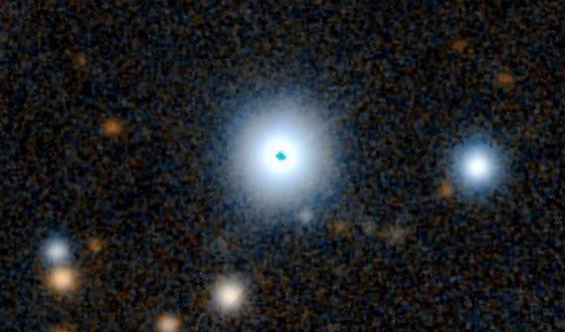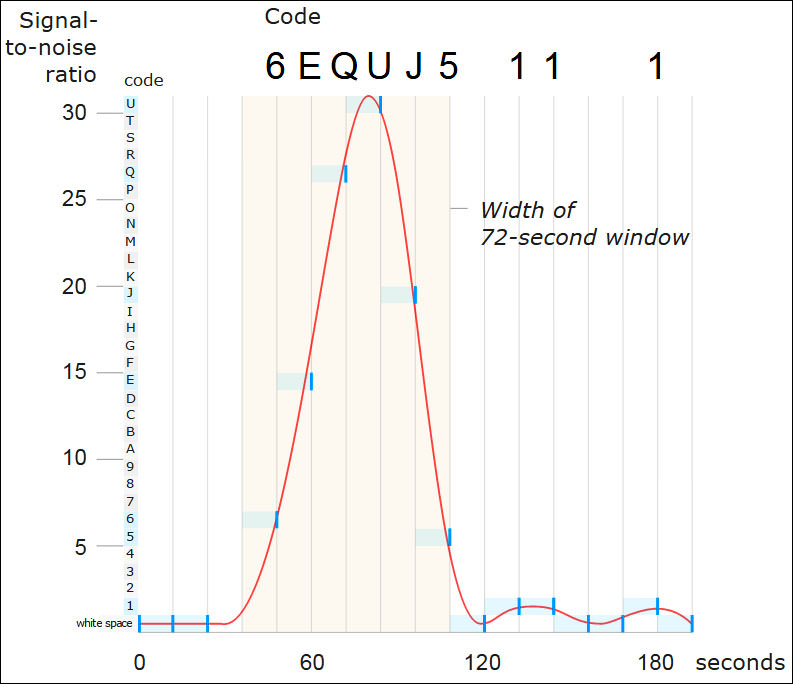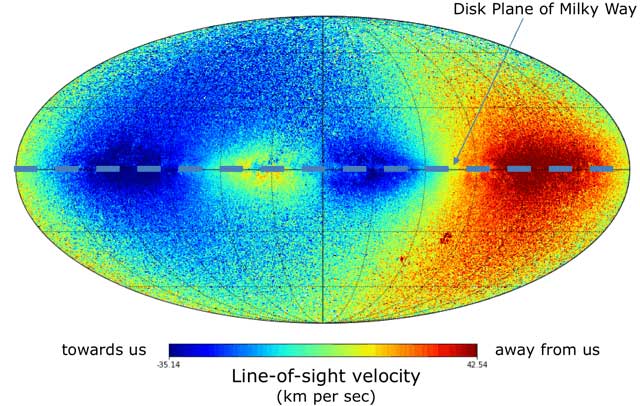

The famous Wow! signal, detected by the Big Ear Radio Observatory in Ohio on August 15, 1977. It was a leading candidate for an extraterrestrial radio signal, but was never heard again. Image via Big Ear Radio Observatory/ North American Astrophysical Observatory.
In August 1977, astronomers detected an unusual radio signal coming from deep space that’s been the subject of intrigue and debate ever since. Known as the Wow! signal, it was heard only once and never again. It still hasn’t been adequately explained. Enter amateur astronomer Alberto Caballero. He’s a founder of The Exoplanets Channel on YouTube and coordinator of the Habitable Exoplanet Hunting Project, which, earlier this year, announced GJ 3470 c, the first exoplanet candidate fully discovered by amateur astronomers. On November 8, 2020, the non-peer-reviewed, open-access repository of electronic preprints arXiv published a scientific paper by Caballero. In it, he said he has narrowed down the source of the Wow! signal. He might even have identified the specific star of origin. It’s a sunlike star – labeled 2MASS 19281982-2640123 – 1,800 light-years away, in the direction to the center of our Milky Way galaxy.
On November 19, The Physics arXiv Blog at DiscoverMagazine.com also announced Caballero’s finding.
The finding is based updated data about our Milky Way galaxy from ESA’s Gaia space observatory, which is in the process of creating a cool new 3-D map of our galaxy. Using data from Gaia’s first and second data releases, Caballero searched for sunlike stars in the region of the sky from which the Wow! signal emanated. Read more about the power of Gaia’s data, below.
For this study, Caballero focused on sunlike stars, from mid-K to G-type (our sun is a G-type star). So far, the only intelligent life we know is here on Earth, so it’s logical to look for extraterrestrial intelligence around stars similar to our sun.
His search of Gaia data revealed 66 potential candidate stars, but one in particular stood out: 2MASS 19281982-2640123, a sunlike star located in the direction to the constellation Sagittarius, along our line of sight to the center of our Milky Way galaxy. As Caballero told Discover:
The only potential sunlike star in all the WOW! signal region appears to be 2MASS 19281982-2640123. This star sits in the constellation of Sagittarius at a distance of 1,800 light-years. It is an identical twin to our sun, with the same temperature, radius, and luminosity.

2MASS 19281982-2640123, a sun-like star 1,800 light-years away in the constellation Sagittarius. It is the best candidate found so far for the origin of the Wow! signal. Image via PanSTARRS/ DR1/ Discover.

Amateur astronomer Alberto Caballero of The Exoplanets Channel and the Habitable Exoplanet Hunting Project wrote the new paper on a sunlike star that might be the source of the Wow! signal. Image via Alba Villar/ Faro de Vigo.
Right now, according to Caballero, 2MASS 19281982-2640123 is the strongest candidate star for being the source of the Wow! signal. As for the other candidates, he said, astronomers need more data about their luminosities or sizes. It’s still possible that one of the other candidates could turn out to be a better fit, but as of now, 2MASS 19281982-2640123 is the one that’s of special interest.
From Caballero’s paper:
In this paper it is analyzed which of the thousands of stars in the WOW! signal region could have the highest chance of being the real source of the signal, providing that it came from a star system similar to ours. A total of 66 G and K-type stars are sampled, but only one of them is identified as a potential sunlike star considering the available information in the Gaia Archive. This candidate source, which is named 2MASS 19281982-2640123, therefore becomes an ideal target to conduct observations in the search for potentially habitable exoplanets. Another 14 potential sunlike stars (with estimated temperatures between 5,730 and 5,830 K) are also found in the region, but information about their luminosity and radius is unknown.
What is the Wow! signal? The Wow! signal of the 1970s is still considered to be the most enigmatic cosmic radio signal yet. It hasn’t been easily explained by terrestrial satellites or other human activity. It was detected by the Big Ear Radio Observatory at Ohio State University in Delaware, Ohio on August 15, 1977. It was an unusually strong signal, easily discerned from the background noise, and lasted 72 seconds.
The signal earned the nickname “Wow!” when Jerry Ehman, the astronomer who found it in the paper data printout, circled it and wrote “Wow!”
Later, in a letter to Carl Sagan, the observatory director John Kraus wrote:
The Wow! signal is highly suggestive of extraterrestrial intelligent origin, but little more can be said until it returns for further study.
The detection was exciting, and, in many ways, still is. Astronomers had pondered what a true artificial signal from an extraterrestrial civilization might be expected to look like. The Wow! signal tentatively fit the bill. The problem was it was heard only once, and never heard again, like a cosmic one-hit wonder.
At the time, Kraus also looked in star catalogs for sunlike stars that might be the source of the signals, but didn’t find any. He said:
We checked star catalogs for any sunlike stars in the area and found none.

The Big Ear Radio Observatory at Ohio State University. It was listed in the 1995 Guinness Book of World Records under the category of Longest Extraterrestrial Search: “The longest-running full-scale SETI (search for extraterrestrial intelligence) project is the Ohio SETI Program at Ohio State University in Columbus, OH, which has searched the universe for extraterrestrial radio signals for 22 years, beginning in 1973.” Image via Bigear.org.
Caballero’s explanation for the Wow! signal isn’t, by any means, the first one.
In 2016, for example, astronomer Antonio Paris hypothesized that the Wow! signal was caused by the faint comet 266P/Christensen, which near the region of the sky at the time. This was based on the possibility that comets could emit radio signals at or close to the same frequency of 1,420-MHz. Other scientists, including Ehman, have remain skeptical of that explanation. Astronomer Seth Shostak at the SETI Institute explained their skepticism succinctly, saying:
I don’t think anyone ever found such emission from comets.

Plot showing the strength of the Wow! signal. Image via Maksim Rossomakhin/ Universe Today.
The power of Gaia’s data. Generally speaking, star catalogs are more complete than they were in the 1970s. But Gaia’s catalog is in a class by itself, the most detailed star catalog ever produced, with 1.3 billion stars.
The European Space Agency (ESA) launched Gaia in 2013. The mission is to create the most detailed 3-D map of the Milky Way galaxy ever made, and is scheduled to continue until 2024.
Gaia gathers its data via what’s called astrometry. That is, it measures not just the positions of stars, but also their movements through space. Gaia’s job is to scan the sky repeatedly, observing each of its targeted billion stars an average of 70 times over the course of its mission. So, for example, we know our sun and all the stars in the Milky Way are moving continuously in great orderly masses around the center of our galaxy. We know that … but we didn’t have many details about how each star moves. How could we? The data for so many stars would be (are) massive; collecting the data, storing it and analyzing it requires today’s spacecraft and computer technologies.
Over its years in space, again and again and again, Gaia will acquire data points on the positions of Milky Way stars. Thus astronomers have already been able to produce an illustration like the very wonderful one below, which shows median velocities (the distances and directions traveled by each star per unit of time) of stars in our Milky Way:

All-sky map of median velocities of about a billion stars toward or away from our sun, made possible by the Gaia mission. When you look at this map, you’re seeing a large-scale pattern caused by rotation of our Milky Way galaxy. Image via DPAC/ESA/STFC.
Whether 2MASS 19281982-2640123 is the source of the Wow! signal remains to be seen, but it is a tantalizing new development in a cosmic mystery that has perplexed astronomers for over 40 years.
And, by the way, Caballero is also working on coordinating with several different radio observatories, on different continents, to search for new radio cosmic signals that might be indicative of extraterrestrial civilizations. He has three such searches lined up so far, with more expected. It will be very interesting to follow the progress of his endeavors.
Bottom line: An amateur astronomer may have have the long-sought origin of the famous mystery Wow! signal detected by a radio telescope in 1977.
Source: An approximation to determine the source of the WOW! Signal
from EarthSky https://ift.tt/3g393Nd


The famous Wow! signal, detected by the Big Ear Radio Observatory in Ohio on August 15, 1977. It was a leading candidate for an extraterrestrial radio signal, but was never heard again. Image via Big Ear Radio Observatory/ North American Astrophysical Observatory.
In August 1977, astronomers detected an unusual radio signal coming from deep space that’s been the subject of intrigue and debate ever since. Known as the Wow! signal, it was heard only once and never again. It still hasn’t been adequately explained. Enter amateur astronomer Alberto Caballero. He’s a founder of The Exoplanets Channel on YouTube and coordinator of the Habitable Exoplanet Hunting Project, which, earlier this year, announced GJ 3470 c, the first exoplanet candidate fully discovered by amateur astronomers. On November 8, 2020, the non-peer-reviewed, open-access repository of electronic preprints arXiv published a scientific paper by Caballero. In it, he said he has narrowed down the source of the Wow! signal. He might even have identified the specific star of origin. It’s a sunlike star – labeled 2MASS 19281982-2640123 – 1,800 light-years away, in the direction to the center of our Milky Way galaxy.
On November 19, The Physics arXiv Blog at DiscoverMagazine.com also announced Caballero’s finding.
The finding is based updated data about our Milky Way galaxy from ESA’s Gaia space observatory, which is in the process of creating a cool new 3-D map of our galaxy. Using data from Gaia’s first and second data releases, Caballero searched for sunlike stars in the region of the sky from which the Wow! signal emanated. Read more about the power of Gaia’s data, below.
For this study, Caballero focused on sunlike stars, from mid-K to G-type (our sun is a G-type star). So far, the only intelligent life we know is here on Earth, so it’s logical to look for extraterrestrial intelligence around stars similar to our sun.
His search of Gaia data revealed 66 potential candidate stars, but one in particular stood out: 2MASS 19281982-2640123, a sunlike star located in the direction to the constellation Sagittarius, along our line of sight to the center of our Milky Way galaxy. As Caballero told Discover:
The only potential sunlike star in all the WOW! signal region appears to be 2MASS 19281982-2640123. This star sits in the constellation of Sagittarius at a distance of 1,800 light-years. It is an identical twin to our sun, with the same temperature, radius, and luminosity.

2MASS 19281982-2640123, a sun-like star 1,800 light-years away in the constellation Sagittarius. It is the best candidate found so far for the origin of the Wow! signal. Image via PanSTARRS/ DR1/ Discover.

Amateur astronomer Alberto Caballero of The Exoplanets Channel and the Habitable Exoplanet Hunting Project wrote the new paper on a sunlike star that might be the source of the Wow! signal. Image via Alba Villar/ Faro de Vigo.
Right now, according to Caballero, 2MASS 19281982-2640123 is the strongest candidate star for being the source of the Wow! signal. As for the other candidates, he said, astronomers need more data about their luminosities or sizes. It’s still possible that one of the other candidates could turn out to be a better fit, but as of now, 2MASS 19281982-2640123 is the one that’s of special interest.
From Caballero’s paper:
In this paper it is analyzed which of the thousands of stars in the WOW! signal region could have the highest chance of being the real source of the signal, providing that it came from a star system similar to ours. A total of 66 G and K-type stars are sampled, but only one of them is identified as a potential sunlike star considering the available information in the Gaia Archive. This candidate source, which is named 2MASS 19281982-2640123, therefore becomes an ideal target to conduct observations in the search for potentially habitable exoplanets. Another 14 potential sunlike stars (with estimated temperatures between 5,730 and 5,830 K) are also found in the region, but information about their luminosity and radius is unknown.
What is the Wow! signal? The Wow! signal of the 1970s is still considered to be the most enigmatic cosmic radio signal yet. It hasn’t been easily explained by terrestrial satellites or other human activity. It was detected by the Big Ear Radio Observatory at Ohio State University in Delaware, Ohio on August 15, 1977. It was an unusually strong signal, easily discerned from the background noise, and lasted 72 seconds.
The signal earned the nickname “Wow!” when Jerry Ehman, the astronomer who found it in the paper data printout, circled it and wrote “Wow!”
Later, in a letter to Carl Sagan, the observatory director John Kraus wrote:
The Wow! signal is highly suggestive of extraterrestrial intelligent origin, but little more can be said until it returns for further study.
The detection was exciting, and, in many ways, still is. Astronomers had pondered what a true artificial signal from an extraterrestrial civilization might be expected to look like. The Wow! signal tentatively fit the bill. The problem was it was heard only once, and never heard again, like a cosmic one-hit wonder.
At the time, Kraus also looked in star catalogs for sunlike stars that might be the source of the signals, but didn’t find any. He said:
We checked star catalogs for any sunlike stars in the area and found none.

The Big Ear Radio Observatory at Ohio State University. It was listed in the 1995 Guinness Book of World Records under the category of Longest Extraterrestrial Search: “The longest-running full-scale SETI (search for extraterrestrial intelligence) project is the Ohio SETI Program at Ohio State University in Columbus, OH, which has searched the universe for extraterrestrial radio signals for 22 years, beginning in 1973.” Image via Bigear.org.
Caballero’s explanation for the Wow! signal isn’t, by any means, the first one.
In 2016, for example, astronomer Antonio Paris hypothesized that the Wow! signal was caused by the faint comet 266P/Christensen, which near the region of the sky at the time. This was based on the possibility that comets could emit radio signals at or close to the same frequency of 1,420-MHz. Other scientists, including Ehman, have remain skeptical of that explanation. Astronomer Seth Shostak at the SETI Institute explained their skepticism succinctly, saying:
I don’t think anyone ever found such emission from comets.

Plot showing the strength of the Wow! signal. Image via Maksim Rossomakhin/ Universe Today.
The power of Gaia’s data. Generally speaking, star catalogs are more complete than they were in the 1970s. But Gaia’s catalog is in a class by itself, the most detailed star catalog ever produced, with 1.3 billion stars.
The European Space Agency (ESA) launched Gaia in 2013. The mission is to create the most detailed 3-D map of the Milky Way galaxy ever made, and is scheduled to continue until 2024.
Gaia gathers its data via what’s called astrometry. That is, it measures not just the positions of stars, but also their movements through space. Gaia’s job is to scan the sky repeatedly, observing each of its targeted billion stars an average of 70 times over the course of its mission. So, for example, we know our sun and all the stars in the Milky Way are moving continuously in great orderly masses around the center of our galaxy. We know that … but we didn’t have many details about how each star moves. How could we? The data for so many stars would be (are) massive; collecting the data, storing it and analyzing it requires today’s spacecraft and computer technologies.
Over its years in space, again and again and again, Gaia will acquire data points on the positions of Milky Way stars. Thus astronomers have already been able to produce an illustration like the very wonderful one below, which shows median velocities (the distances and directions traveled by each star per unit of time) of stars in our Milky Way:

All-sky map of median velocities of about a billion stars toward or away from our sun, made possible by the Gaia mission. When you look at this map, you’re seeing a large-scale pattern caused by rotation of our Milky Way galaxy. Image via DPAC/ESA/STFC.
Whether 2MASS 19281982-2640123 is the source of the Wow! signal remains to be seen, but it is a tantalizing new development in a cosmic mystery that has perplexed astronomers for over 40 years.
And, by the way, Caballero is also working on coordinating with several different radio observatories, on different continents, to search for new radio cosmic signals that might be indicative of extraterrestrial civilizations. He has three such searches lined up so far, with more expected. It will be very interesting to follow the progress of his endeavors.
Bottom line: An amateur astronomer may have have the long-sought origin of the famous mystery Wow! signal detected by a radio telescope in 1977.
Source: An approximation to determine the source of the WOW! Signal
from EarthSky https://ift.tt/3g393Nd


Aucun commentaire:
Enregistrer un commentaire